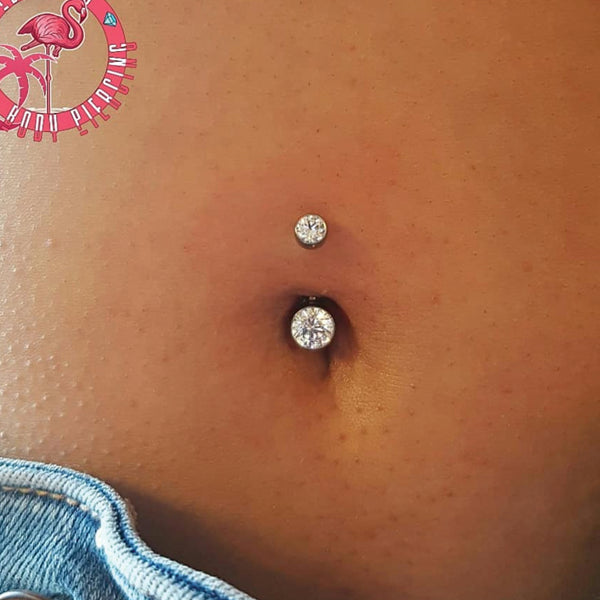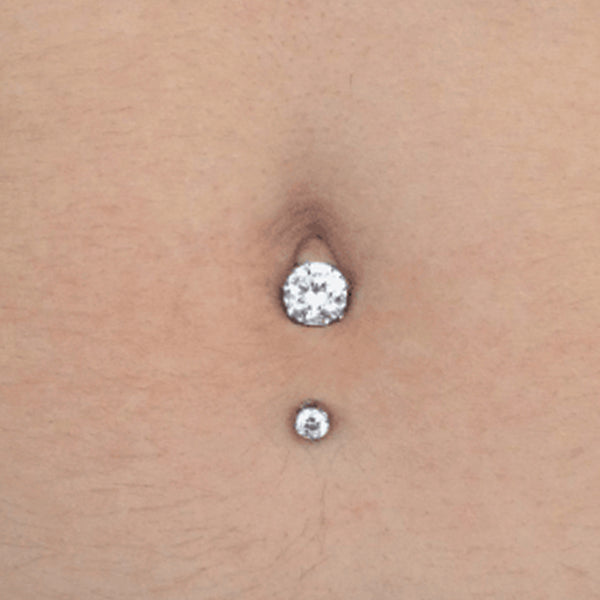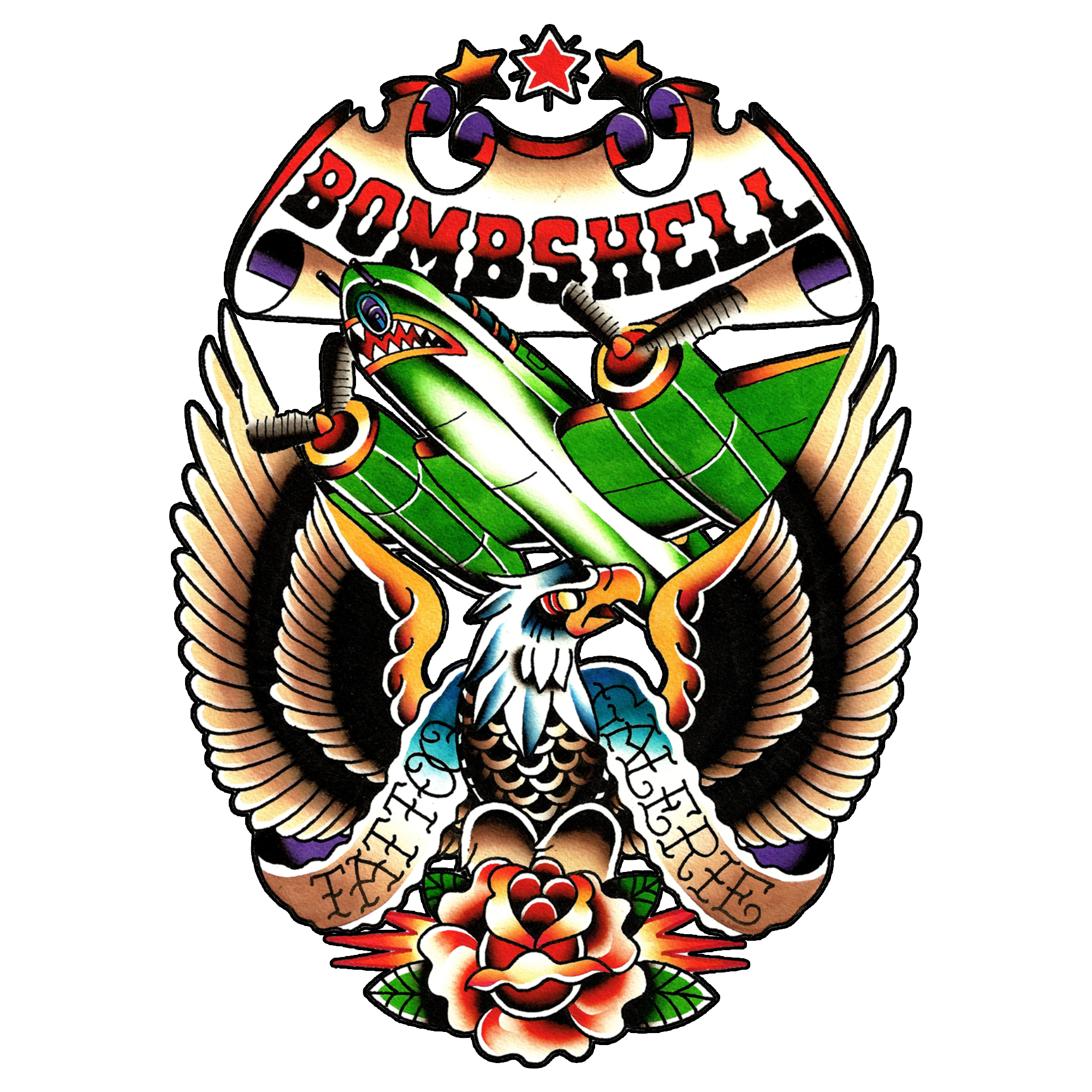NAVEL PIERCINGS
Our piercer can assess your personal anatomy to let you know what kind of navel piercing will work best for you!

UPPER NAVEL
Popularized in the early 90s the navel piercing is a fantastic way to bring attention to your midriff in those summer months, however, not all navels are suitable for piercing, more specifically not all navels are ideally shaped for healing a piercing.
In order to be a good candidate for navel piercing, it is ideal that you have a protruding lip of skin on the top of your navel, with enough space behind the flap for jewelry to sit comfortably.
Healing time is 6 months to a year

LOWER NAVEL
Similarly to the upper navel piercing mentioned above, in order to be a good candidate for a lower navel piercing, it is ideal that you have a protruding lip of skin on the bottom of your navel, with enough space behind the flap for jewelry to sit comfortably.
Healing time is 6 months to a year.
Navel piercing FAQ
Why do they take so long to heal?
Due to its location, a navel piercing is subjected to constant agitation from bending, stretching, folding, and the friction caused by adjacent clothing. The piercing is also in a location that has little surface blood flow, it is not an overly "vascular" area. Restricted blood flow to the piercing site also lengthens healing time.
Together these two factors result in a long healing process, healing on a navel piercing is typically anywhere from six months to a year and we are not exaggerating.
Due to this prolonged healing time, navel piercings are more likely to develop problems during healing than the majority of piercings.
While a properly treated piercing may never give you problems, a wound that is healing for up to a year has a much greater chance of getting irritated—or even infected. To prevent this from occurring, ensure you are following our aftercare instructions and do not allow your piercing to come into contact with potential contaminants, avoid handling your piercing, and do not allow others hands, mouths or bodily fluids to come into contact with it.
Why cant I get a navel piercing?
While many non professional piercers will allow any client to get their navel pierced, we are more selective. Yes anyone can get pierced but unfortunately not every client can heal a navel piercing and we always have your health and wellbeing as our number one priority.
So that you can heal properly your navel must have a good lip of skin (similar to an earlobe) above the navel (or below for lower navel piercings) with space both behind and below the lip for the jewellery to sit without constant pressure. Without a well-defined “lip” of skin to place the piercing through, there are increased chances for problems while healing—including the piercing rejecting. Likewise, attempting to pierce navels that do have a flap but do not have enough space behind them to allow jewellery to sit comfortably will generally result in a difficult and problematic healing process as the jewellery is constantly being pushed forwards.
This is why when clients come to Bombshell requesting a piercing, we will have our professional piercer take a look at their navel and discuss the viability of the piercing and any potential healing issues first.
If you come to us requesting a navel piercing and our piercer does not think your navel has a good chance of healing properly, we may decline the piercing for your own health and safety.
When can I go swimming?
We always recommend you avoid swimming for the first month after receiving any new piercing, but that risk to your piercing does vary depending on where you’re swimming.
Fresh clean saltwater and chlorine may be okay for your piercing however, other bacteria hidden in the water may be problematic to your piercing.
Ocean water tends to be great for speeding healing, but the water on a beach in tropical Australia is not the same at the water at Alberta Beach. While we can't control your actions once you leave our studio, we do recommend you use common sense and assess the potential risk you are placing your new piercing in before entering water, and definitely avoid hot tubs, quarries, or lakes as the water quality is even more questionable.
If you do go swimming whilst healing your piercing, always ensure that you clean your piercing thoroughly afterward.
Can I do sit-ups? like, can I work out?
Doing exercise or more specifically sit ups usually don’t present a problem for you or your piercing, but we do recommend that you avoid sit ups for the first few weeks.
Sweat should not effect the healing of your new piercing, but we do recommend you ensure to clean your piercing after each workout to avoid a buildup of bacteria.
Should I take out my navel piercing when I'm pregnant?
While the shape of your navel is guaranteed to change as your stomach stretches to accommodate a growing infant, whether or not you take your jewelry out when pregnant is up to you, and what your particular body does to the piercing area.
in our experience during the later stages of a pregnancy, the navel can stretch flat or in some cases even turn inside-out, which obviously makes wearing jewelry uncomfortable.
Some women find this pressure on the jewelry uncomfortable, and in rare cases unbearable, and they remove the jewelry and let the piercing close; others women have no discomfort and leave their jewelry in the whole time.
Should you chose to remove the jewelry, in many cases, especially if the navel piercing is several years old and has fully healed before the pregnancy begins, jewelry can simply be removed and put back in after the delivery.
If you remove your jewelry on a newer piercing and your piercing completely closes, you can typically get it re-pierced after you have returned to normal function. We never pierce or tattoo clients whom are breast feeding as trying to heal a wound is difficult while your body is already directing energy elsewhere, so we recommend that if you are intending on breastfeeding that you wait until you are no longer doing so before contacting our piercer and booking to get re-pierced.
What to expect
Body piercings vary in healing times anywhere from 8 weeks to a several months depending on the
piercing site.
Everyone’s body is different so be patient and allow your body the time it needs to heal.
Initially there may be bleeding, or occasionally slight bruising around the piercing site.
Slight to moderate swelling can be expected.
The tissue around the piercing can become tender and slightly
red/pink during the first few weeks of healing.
A clear or light yellow discharge might occur off and on indefinitely. This discharge forms a crust which you can rinse off gently with warm water.
Do not touch or pick at your piercing and never rotate the jewelry while your piercing is healing!
What to do
Rinse your piercing twice daily (or as recommended by your piercer) in warm running water to soften and remove any crust that may have formed around your piercing.
Warm water helps keep the area clean as well as increasing circulation which is beneficial to healing.
After the warm water rinse, follow with Simple Care Spray or a Sterile Wound Wash Saline available at any pharmacy.
Spray directly on the piercing twice daily and leave your piercing
alone.
DO NOT make your own salt solution at home as this can impede healing.
We are not responsible for lost jewellery so please check your jewellery daily with freshly washed hands.
Threaded jewellery can loosen and fall off.
Playing with your jewellery not only increases your chances of complications during healing, but it may also result in the loosening of threaded ends and in turn
the loss of the piercing site so keep your hands away from your piercing as much as possible.
Ensure anything that comes into contact with your piercing such as clothing, bedding, towels etc. are
clean until your piercing is fully healed.
What not to do
Do not touch your piercing unless you are checking the threading. Do not allow anyone else to touch your piercing.
Never pick at or rotate your jewellery.
Do not use Q-Tips or cotton swabs or any other materials that may leave fibres behind.
Do not bandage your piercing. Refrain from wearing tight clothing.
Do not use antibacterial soaps, peroxide, rubbing alcohol, Bactine, antibiotic ointments (Polysporin)or other first aid products unless instructed to by your doctor.
Do not submerge your piercing in any bodies of water including bathtubs, lakes, oceans, hot tubs swimming pools, saunas etc. until it is fully healed.
Do not remove or change your jewellery for at least 8-12 weeks or as directed by your piercer.
Always check with your piercer as to suitable jewellery options for your particular piercing and anatomy and always be aware of the quality of the jewellery you are putting in your body.
Do not share jewellery. This puts you at risk for disease and/ or infection transmission.
Do not rely on the advice of friends, family or the internet. Your piercer knows what works best for their practices.
If your piercer is unavailable, or if you suspect complications or infection please contact your doctor.

